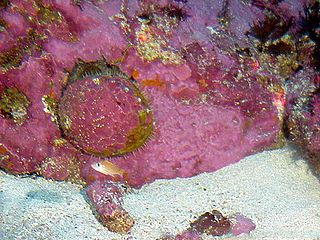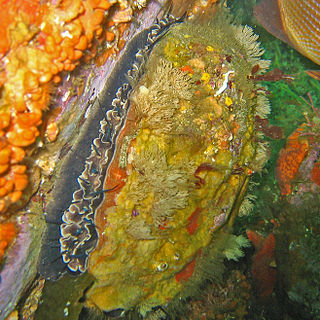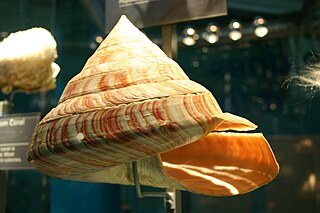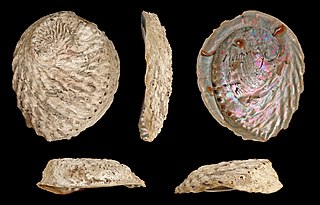Related Research Articles

Abalone is a common name for any of a group of small to very large marine gastropod molluscs in the family Haliotidae.

Haliotis cracherodii, the black abalone, is a species of large edible sea snail, a marine gastropod mollusk in the family Haliotidae, the abalones.

The white abalone, scientific name Haliotis sorenseni, is a species of large sea snail, a marine gastropod mollusk in the family Haliotidae, the abalones.

Haliotis laevigata, common name the smooth Australian abalone or greenlip abalone or whitened ear shell, is a species of sea snail, a marine gastropod mollusk in the family Haliotidae, the abalones.

Haliotis rufescens is a species of very large edible sea snail in the family Haliotidae, the abalones, ormer shells or paua. It is distributed from British Columbia, Canada, to Baja California, Mexico. It is most common in the southern half of its range.

Pleurotomariacea is one of two names that are used for a taxonomic superfamily of sea snails that are an ancient lineage and are well represented in the fossil record. The name Pleurotomariacea is used by paleontologists, who, because they usually have only the hard parts of mollusks to study, often use a slightly different scheme of classification from that used by scientists who study living mollusks.

The blacklip abalone, Haliotis rubra, is an Australian species of large, edible sea snail, a marine gastropod mollusk in the family Haliotidae, the abalones.

Haliotis gigantea, common name the giant abalone, is a species of sea snail, a marine gastropod mollusk in the family Haliotidae, the abalones. It is known as Siebold's Abalone, after Philipp Franz von Siebold.

Haliotis discus, commonly called "disk abalone," or "Edo abalone," is a species of abalone sea snail.

Haliotis fulgens, commonly called the green abalone, is a species of large sea snail, a marine gastropod mollusc in the family Haliotidae, the abalones. The shell of this species is usually brown, and is marked with many low, flat-topped ribs which run parallel to the five to seven open respiratory pores that are elevated above the shell's surface. The inside of the shell is an iridescent blue and green.

Haliotis midae, known commonly as the South African abalone or the perlemoen abalone, is a species of large sea snail, a marine gastropod mollusk in the family Haliotidae, the abalones.
Shewanella haliotis, a species of rod-shaped, Gram-negative, facultatively anaerobic bacteria, was first isolated from the gut microflora of abalones collected from the ocean near Yeosu, South Korea, by Kim et al. in 2007. Further studies showed the cells to be catalase- and oxidase-positive. The species epithet haliotis is a reference to the genus name of abalones, Haliotis.

Haliotis, common name abalone, is the only genus in the family Haliotidae.
Aurivirus is a genus of viruses in the order Herpesvirales, and one of only two genera the family Malacoherpesviridae. Haliotid molluscs serve as natural hosts. There is only one species described in this genus, Haliotid herpesvirus 1 (AbHV-1), commonly known as abalone herpesvirus. A disease associated with this virus is acute ganglioneuritis.
Oceaniserpentilla haliotis is a Gram-negative and aerobic which has been isolated from the haemolymph serum of the sea snail Haliotis rubra from Tasmania in Australia. Oceaniserpentilla haliotis has the ability to degrade crude oil. It is the only species in the genus Oceaniserpentilla.
Pseudoruegeria haliotis is a Gram-negative, rod-shaped, aerobic and non-motile bacterium from the genus of Pseudoruegeria which has been isolated from the gut of an abalone from the coast of Jeju Island in Korea.
Tenacibaculum haliotis is a bacterium from the genus of Tenacibaculum which has been isolated from the gut of an abalone from the sea near Jeju island in Korea.
Shimia haliotis is a Gram-negative, rod-shaped and motile bacterium from the genus of Shimia which has been isolated from the intestinal tract of an abalone from the Jeju Island in Korea.
Formosa haliotis is a Gram-negative, aerobic, rod-shaped bacterium from the genus of Formosa which has been isolated from the marine snail Haliotis gigantea in Japan.
References
- 1 2 "Paraferrimonas". LPSN .
- 1 2 "Paraferrimonas haliotis". www.uniprot.org.
- ↑ Huang, J; Huang, Z; Shao, Z (December 2017). "Paraferrimonas haliotis sp. nov., isolated from the intestine of abalone, Haliotis discus hannai and emendation of description of the genus Paraferrimonas". International Journal of Systematic and Evolutionary Microbiology. 67 (12): 5062–5066. doi: 10.1099/ijsem.0.002414 . PMID 29039303.